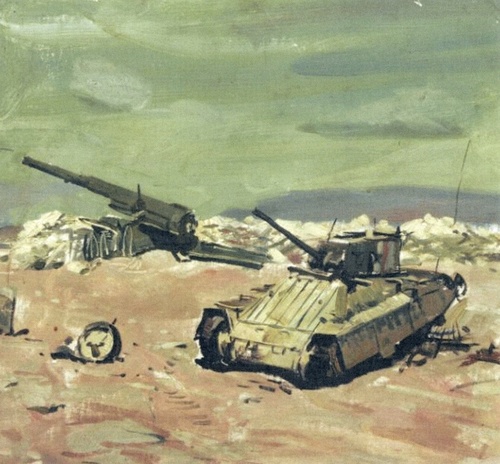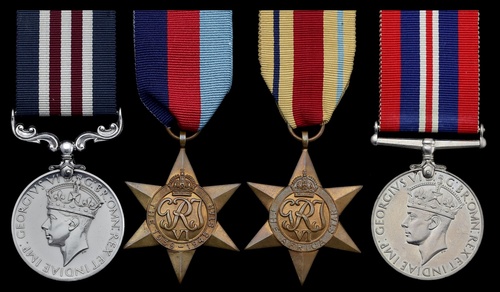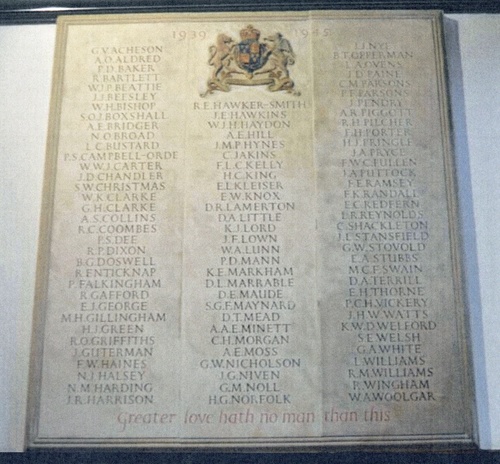Auction: 20001 - Orders, Decorations and Medals - conducted behind closed doors
Lot: 709
An outstanding North Africa 'Hellfire Pass' 1941 M.M. group of four awarded to Trooper H. G. Norfolk, Royal Tank Regiment, who remained alone inside a tank which had been repeatedly struck by German 88mm anti-tank fire, successfully extinguished a fire which raged inside and then managed to drive his vehicle to a place of safety for repair
He died a month later aged just 21 years, in consequence of wounds received in action - likely the burns and shrapnel suffered whilst winning his M.M.
Military Medal, G.VI.R. (7901477 Tpr. H. G, Norfolk. R. Tank R.); 1939-45 Star; Africa Star; War Medal 1939-45, good very fine (4)
M.M. London Gazette 17 October 1941.
The official recommendation - originally for a D.C.M. - compiled by Lieutenant-Colonel William O. L. O'Carroll, commanding officer, 4th Royal Tank Regiment, and approved by Field Marshal Sir Claude J. E. Auchinleck, states:
'About 0700hrs on June 15 at Halfaya, the tank of which Tpr. Norfolk was driver came under very heavy fire. It was hit repeatedly and finally was set on fire though still running. The tank was evacuated by all but Tpr. Norfolk who crawling into the fighting chamber from his seat, endeavoured to extinguish the fire which raged inside. Despite the imminent danger of ammunition exploding he continued to fight the fire until he extinguished it. He then drove the tank out of action to a place of safety where it could be repaired. The courage and devotion to duty, and the superb disregard of his own personal safety displayed by Tpr. Norfolk while faced with such a variety of contingencies is deserving of the highest praise, and the example he set is worthy of the highest traditions of the Service.'
O'Carroll went on to add in his own handwriting, beneath the typed citation:
'Trooper Norfolk displayed courage and determination of a very high order - very strongly recommended.'
Henry George Norfolk was born around 1920 at Guildford, the son of Stanley Thomas and Rose May Norfolk of 30 Elmbank Avenue, Guildford Park, Guildford, Surrey. Educated from 1933-38 at the 'Free School' for boys, more commonly known today as the Royal Grammar School Guildford, Norfolk served as a member of the school O.T.C., which had flourished since 1914 when it provided many of the junior officers for Kitchener's 'new armies' (Surrey in the Great War, refers). Leaving school, he took his first employment locally in the butchery department of the Guildford and District Co-operative Society on the corner of Woodbridge and Leapale Roads in the town centre, before enlisting into the Army in 1939 (The Surrey Advertiser, refers).
Perilous times
As the spring gave way to summer in 1941, the Axis threat to the Middle East assumed ever larger proportions in London. As Hitler looked set to complete his destruction of the Soviet Union by the end of August, a detailed analysis presented to Winston Churchill and his War Cabinet by the Joint Intelligence Sub-Committee made it reasonable to conclude that, with Russia at his mercy, the Fuhrer would turn on the Middle East. The Wehrmacht would be ordered to cross into Turkey and then Syria before 'throttling the carotid artery of the British Empire' by seizing Egypt and the Suez Canal (Destiny in the Desert, refers) via a two-pronged attack commencing in Libya and Bulgaria.
Tabled by General Friedrich Paulus and presented to Rommel in April 1941 a detailed analysis of the plan - drafted as Hitler's Order No. 32 on 11 June 1941 - showed that the threat was very real and far more than one general's whim. Whilst Hitler's hubristic vision knew few bounds, the prospect of a renewed offensive by Rommel coupled with panzer divisions redirected from a conquered Russia was very real to the British; indeed at that time it would have seemed treasonably irresponsible to have presumed otherwise. By the start of July 1941 the first phase of the war in the Middle East was done, but as Wavell made way for Auchinleck it soon became clear that the Allies had to prepare for bigger offensives; as a result, the Army of the Nile rose in a very short space of time to over half a million men including Australians, New Zealanders, South Africans, Indians, Poles, Czech, Free French, Palestinians and Sudanese.
Outward Bound: 4th Royal Tank Regiment
In October 1940, 'B' Squadron of 4 R.T.R. departed barracks at East Grinstead and moved at short notice with 16 Matilda Mk. 2 tanks to Eritrea where they successfully defeated Italian forces in the battle for Massawa. The Italians had no answer to the fast marauding tanks and soon capitulated. Meanwhile on 18 December 1940, the remainder of the 4th R.T.R., likely including Trooper Norfolk, sailed in convoy aboard H.M.T. City of London from Liverpool to Port Tewfik, Suez, arriving on 16 February 1941. Their journey was an eventful one which included an Atlantic hurricane, collision at night with another ship in the convoy and an engagement with the Admiral Hipper (The History of the 4th and 7th R.T.R., refers), but the men arrived safely and were joined by their tanks in April 1941. On 12 May 1941 the Tiger Convoy arrived at Alexandria with a further 238 tanks destined for 7th R.T.R., including 21 Light Tank Mk. VI's, 82 Cruiser tanks - of which 50 were the new Crusader tank - and 135 infantry tanks. After conversion to cope with the desert dust they were ready for battle.
On 6 April 1941 the German Army invaded Greece. The hastily-assembled and isolated British forces were soon overwhelmed and lost 12,000 men in the withdrawal - as well as all their equipment. At around the same time, Rommel successfully struck east at Mersa Brega and was back at the Egyptian frontier having by-passed Tobruk. For Trooper Norfolk and many of his fellow tank crews their first indication that the Germans were coming were powerful radio transmissions from Belgrade, as the German force to be known as the Afrika Korps pumped themselves up with 'Lili Marleen' and emotional farewell parades before unloading at Tripoli.
On 15 May 1941, the 4th R.T.R. faced their first stern test in North Africa during Operation Brevity. Planned as a rapid blow against weak Axis front-line forces around Sollum, Fort Capuzzo and Bardia on the Egyptian-Libyan border, the British attempted to cut off Axis supply lines from Tripoli, capture ground from which to launch an offensive towards Tobruk, and inflict significant losses on the enemy. Advancing at dawn, the 4th R.T.R. advanced in a heavy sandstorm and 'C' Squadron successfully captured Halfaya Pass, supported by the 2nd Battalion, Scots Guards. In contrast 'A' Squadron under Major Banks, supported by the 9th Battalion, Durham Light Infantry, were mauled; meeting a force of 25 German tanks, Banks lost 12 of his 14 tanks and had to give up all hope of taking Fort Capuzzo. Heavily repulsed by counter-attacks of the 15th Panzer Division, the 4th R.T.R. conducted a staged withdrawal back to the Halfaya Pass the following day. Ten days later on 27 May 1941, the Germans successfully launched Unternehmen Skorpion with a demonstration of force on a wide front. The bluff by Kampfgruppe von Herff, Gruppe Cramer and Gruppe Bach succeeded, and the Pass was re-occupied by Axis troops.
Operation Battleaxe
On 15 June 1941, XI Corps under Lieutenant-General Noel Beresford-Peirse moved to destroy the Axis garrisons of Halfaya Pass, Bardia, Sollum, Capuzzo and Sidi Aziez. Tasked to capture the Pass, Trooper Norfolk and the rest of 'C' Squadron, 4th R.T.R., in conjunction with infantry of the Cameron Highlanders and supported by two batteries of 25-pounder artillery - shared between the O.C. 'A' Squadron and the O.C. 'C' Squadron - left their positions at 0600hrs and began to make their way towards the gap in the escarpment. Almost immediately the plans began to go awry, the Matilda tanks being under accurate German 88mm fire from the start:
'For some reason, yet unexplained, the Arty failed to give concentrated fire at 06.00hrs as arranged. 'C' Squadron proceeded to attack and arrived in the vicinity of the objective at 06.05hrs - coming under very heavy fire. Fighting continued until 09.30hrs by which time only one tank was fightable and this had a jammed turret and could not direct fire, also damaged transmission and was therefore unable to take cover. Meanwhile the Camerons had de-bussed at Bir Elsiweiyat and moved about 1000 yards, advanced and took cover during which time they came under very heavy fire. At about 10.30hrs a company of this Battalion was counter-attacked by armoured cars and no support could be given as the tank which may have provided it was unfit to do so. By evening this tank had its turret repaired and could direct its fire. Shell fire continued during that day. Casualties for the 15th June, 1941, amounted to: Vehicles 11. Personnel: Officers 3, men 14' (The War Diary of the 4th R.T.R., refers).
As the Germans peered down into the Pass from well-concealed positions, the losses faced by 4th R.T.R. became critical. Gruppe Bach in particular, named after its Commander, Major Wilhelm Georg Bach (a former Lutheran pastor of Mannheim and recipient of the Knights Cross) proved highly efficient at 'brewing up' the vulnerable British tanks of 'C' Squadron. One tank commander, Major Miles of 'C' Squadron was clear as to the trap which he had driven into when he described in his last transmission the impact of some 88mm guns on his fellow crews:
'These bloody guns are tearing my tanks to pieces!' (The History of the 4th and 7th R.T.R., refers).
As with Operation Brevity, the Desert Fox had been forewarned by his field intelligence - the interception of radio communications between British units - which gave him precise information about Beresford-Peirse's every manoeuvre. Thus Rommel was able to arrest the British advance with a speed and accuracy which flummoxed British commanders. Private Lamb of the Durham Light Infantry watched in dismay as six 'Matilda' infantry tanks trundled forward:
'I waved at the tanks hoping they would pepper the enemy front. No way! They were all wiped out. Then about an hour later, I looks and all of a sudden there were about six Jerry tanks coming for us, and I shouted, "Right lads, every man for himself. Live to fight another day or else you've had it. Follow me." And we dashed away…we ran like hell' (Destiny in the Desert, refers).
That evening, the surviving infantry dug-in and were shelled periodically during the night. At 0730hrs on 16 June 1941, the Maharatas attacked up the pass, but were held up two hours later by heavy enemy machine-gun fire from concealed positions. The 2nd Battalion, Cameron Highlanders, supported by an 'I' tank and light tank went forward in an attempt to hold the southern edge of Halfaya Wadi, but were forced to a standstill (The War Diary of the 4th R.T.R., refers). As a result, the surviving tanks withdrew to the right flank to take up a position of cover and offer the option of escape. As they moved along the coast road, six tanks of 4th R.T.R. hit an unmarked minefield:
'There was neither engineer nor infantry support. As the tanks were destroyed one by one, 2nd Lieutenant Pip Gardner shepherded the survivors including wounded back to safety. The Trp. Leader, 2nd Lieutenant Roe, had lost both legs, an arm and an eye. He was too heavy to move. Gardner, administering morphine, stayed with him until he died. Recommended for the V.C., his citation later spoke of gallantry 'rarely surpassed in the history of the service' for stripping key parts from one disabled tank after another to prevent use by the enemy; he got the M.C.' (The History of the 4th and 7th R.T.R., refers).
In the rearguard the men of B' Squadron, newly returned from Eritrea, watched as their comrades were decimated by the newly-arrived and expertly-sighted 88mm guns from Greece. Operation Battleaxe had failed and four days later General Wavell was replaced in command of the Middle East by General Sir Claude 'The Auk' Auchinleck. Churchill was alone at Chartwell, his country retreat in Kent, when he heard the news. Having invested so much of his personal credibility in Battleaxe he was more than usually downcast about the outcome. By his own account, he 'wandered about the valley disconsolately for some hours', reflecting on yet another defeat on a battlefield in which a British force had been comprehensively outfoxed and outfought. Although they had managed to escape before the Afrikakorps cut off their line of retreat, the British had lost 381 men dead or missing and 588 wounded. Rommel had endured heavier human casualties but he had lost only twelve tanks. The British had lost almost eight times as many, ninety-one tanks, two thirds of the total which had gone into action; Wavell's gloomy prognosis about the likelihood of success had proved distressingly well founded (Destiny in the Desert, refers).
The German strongpoint of Halfaya Pass held out long after the battle had passed them:
'They were literally starving when they finally surrendered seven months later in January 1942' (The History of the 4th and 7th R.T.R., refers).
Perhaps more remarkable was the fact that the German defenders had managed to survive so long without any kind of reliable water supply:
'Water was unobtainable anywhere, except in the main oases and in the odd well which we knew of; but most of them had been poisoned by the Germans, or by ourselves, or were rancid with camel dung…' (Captain Lloyd Owen, Long Range Desert Force, Destiny in the Desert, refers).
With his supply lines cut, one of Rommel's favourite and most respected officers finally fell into Allied hands. A popular and iconic figure, eternally seen smoking cigars and wearing his myopic glasses, Bach and the scattered survivors of Infanterie Regiment 107 were sent to Canada - where their 'amiable Christian' Major died (Rommel's Desert Commanders, refers).
The Final Roll of the Dice
Awarded the M.M. for his bravery during the first day of Operation Battleaxe and the failed assault on Halfaya Pass, Trooper Norfolk was likely evacuated to No. 1 General Hospital at Kantara after being wounded in action. For a month he clung to life, but sadly died on 16 July 1941 as a result of his injuries and illness (The Surrey Advertiser, refers). On 25 October 1941 it was publicly announced in the local press that Trooper Norfolk had been awarded the Military Medal for 'gallant and distinguished services in the Middle East.' A short while later Stanley and Rose Norfolk travelled to an investiture at Buckingham Palace and were presented the award from the hand of His Majesty King George VI (The Surrey Advertiser & County Times, refers).
Aged just 21 years, Trooper Henry George Norfolk is buried at Kantara War Memorial Cemetery on the eastern side of the Suez Canal; sold with copied recommendation, War Diary entries and research.
Sources:
British Armoured Divisions and their Commanders 1939-1945, Richard Doherty.
Destiny in the Desert: The Road to El Alamein - the Battle that turned the Tide, Profile Books, Jonathan Dimbleby.
Rommel's Desert Commanders: The Men who Served the Desert Fox, North Africa, Samuel W. Mitchem, Jr.
The Desert War: The Classic Account of War in North Africa 1940-43, Alan Moorhead.
Subject to 20% VAT on Buyer’s Premium. For more information please view Terms and Conditions for Buyers.
Sold for
£3,800
Starting price
£1600









